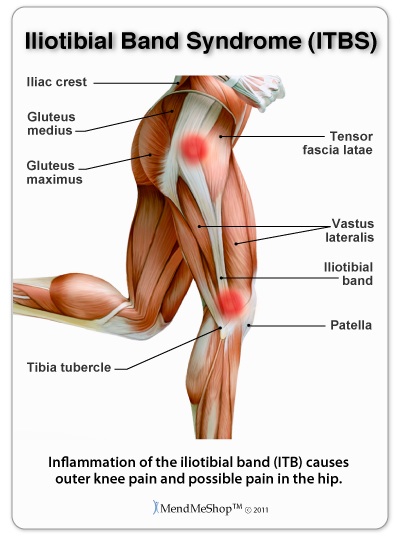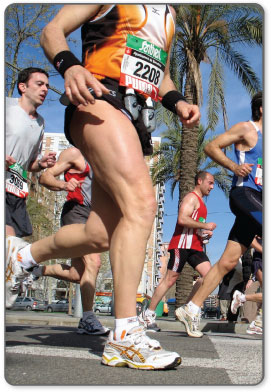
The ITB (also called the iliotibial band or iliotibial tract) is a thick, fibrous tendon that runs along the outside of each leg. These bands run from the iliac (crest of the pelvis), over the greater trochanter at the side of the hip, down the leg, and inserts on the outside of the knee at the top of the tibia (tibial tubercle). Each ITB works with the thigh muscles during flexion and extension of the knee to slow you down when running and helps provide stability to the knee joints.
Iliotibial Band Syndrome (ITBS) is a common condition in athletes, especially runners and cyclists, and occurs when the IT band becomes irritated, inflamed and tight. Excessive rubbing of the IT band over the tibial tubercle (bony prominence at the outside of the knee) is a common cause of the irritation that leads to inflammation, tightness and pain. In addition to knee pain, soreness in the hip may also occur.
The initial pain of ITBS is cause by tightness, irritation, and inflammation in the IT band. Once inflammation in the IT band is reduced and healing begins, scar tissue starts to develop on the iliotibial tract. This scar tissue is tough and inflexible and it stops the muscles attached to the IT band from moving smoothly. This causes further pain at the knee and the tightness is usually felt in the hip (at the top of the iliotibial tract) and down the leg to the knee.
Symptoms of ITBS in runners usually begin with pain developing during a run which subsides shortly after the run finishes. Pain continues to appear with every run eventually progressing to more constant pain while walking or going up or down stairs.
The risk of iliotibial band syndrome can increase with any condition or activity that may cause excessive rubbing of the ITB, such as:
Your doctor will do a physical examination which may include range of motion tests. He or she may arrange x-rays and/or an MRI. An x-ray will rule out calcification or bone spurs in the area. An MRI can identify the inflammation or damaged IT band. It can also determine if there is any other damage in the soft tissue neighbouring the iliotibial tract.

Initial treatment of iliotibial band syndrome should focus on resting your leg and reducing the inflammation to help relieve pain. Do not train through the pain. It may be necessary to stop training for some time until pain and inflammation is reduced.
Many people make the mistake of thinking that once the pain and swelling is down, the IT band is healed. At this point they start getting more active again until - all of a sudden - they experience another injury, sometimes worse than it was before. This is because the IT band soft tissue was not properly healed in the first place, not to mention there is likely scar tissue in the area from the initial injury. Scar tissue is inflexible and is often the source of more injury going forward; treating this scar tissue is the best way to get rid of iliotibial band syndrome and prevent it from popping up again. This is why you must heal the injury thoroughly before returning to activity, and this means boosting your bodys ability to heal - for this we recommend treatments with the Back/Hip TShellz Wrap®. (the Back/Hip wrap can be fitted anywhere along the outside of the leg - ie. the hip or knee area)
Reducing scar tissue is the most important step in treating ITBS. It will improve elasticity in your IT band, allowing your muscles to glide smoothly once again to prevent further inflammation.
Complete your IT band treatments with blood circulation boost therapy, via use of the Back/Hip TShellz Wrap®. It is an effective home treatment tool used to enhance your body's own healing process by simply increasing blood flow. As blood flow increases in soft tissue along the outer leg (the area you treat using the wrap), the health of your tissue is boosted by delivering an abundance of nutrients to the area while simultaneously improving the flexibility of soft tissue in the knee. As soft tissue becomes more flexible, there is less microtearing during exertion which is how scar tissue develops.
To decrease inflammation and swelling and relieve the pain of ITBS, doctor's recommend cold compression. Frequent, cold compression treatments within the first 72 hours of the iliotibial tendon becoming inflamed is an effective way to relieve pain and swelling while limiting the amount of damage done to your tissue. In addition, cold therapy can reduce, or even eliminate, the need for NSAIDs (non-steroidal anti-inflammatory drugs) that can be harmful to your body.
Cold therapy works by interrupting and slowing nerve and tissue function in the injured area and reducing swelling that can block blood vessels. This is important because once blood vessels are blocked or damaged, they can no longer carry oxygen and nutrients to your iliotibial tract and tissues begin to break-down. Without cold therapy, cellular break-down and tissue damage continues because the cells do not get the oxygen they need to survive.
By limiting the amount of damage done to your tissue, you limit the amount of healing that needs to occur. This is a very important step to heal your IT band faster and with less pain!
After severe inflammation and swelling is reduced you can begin to treat your IT band with a blood flow circulation booster. Circulatory Boost increases the amount of blood that flows naturally to your iliotibial tract, transporting vital nutrients to injured tissue to promote your body's natural healing process. In addition, the fresh blood flow whisks away dead tissue and toxins that have built up from the injury leaving the area clean and able to heal faster.
When you stop moving your knee because it hurts the blood flow is reduced, limiting your body's natural ability to heal itself.
By treating your knee and IT band with Circulatory Boost you can increase your body's blood supply to the treatment area, augmenting the bodys natural healing power.
With Circulatory Boost, soft tissue are safely and gently stimulated. Your body responds with a rapid increase in blood flow to the area, increasing the supply of oxygen and nutrients to soft tissue to promote healing. The Back/Hip TShellz Wrap® from MendMeShop® provides effective, non-invasive, non-addictive pain relief while stimulating blood flow with no side effects.
Improved blood flow helps reduce the risk of atrophy in your muscles. When you stop moving your leg and knee due to pain, your muscles and other tissue can become weaker and dead tissue and toxins in the area can cause further tissue deterioration - this can lead to atrophy in your quadriceps, hamstrings and other leg muscles. By clearing the area of toxins and increasing the amount of oxygen and nutrients to your IT band and leg muscles, the risk of atrophy (muscle weakness and/or deterioration) is greatly reduced. Keeping your upper leg and knee joint tissue as healthy as possible throughout the healing process will allow you to improve leg strength again once your pain has gone and your IT band has healed.
Click here to learn more about how Circulatory Boost and TShellz Wraps® work.
Through proper used of conservative treatments such as cold compression and TShellz Wraps® you will notice significantly reduced pain, quicker recovery, and an improvement in the range of motion of your knee and leg.
If you are experiencing knee pain, it is recommended that you see your doctor for a proper diagnosis as there are many injuries and conditions that could be the cause of your pain. An MRI will help your doctor determine what damage has been done, the proper treatments, whether surgery is necessary, and which procedure will be performed. Speak to your doctor before using any of our outstanding products, to make sure they're right for you and your condition.
During your recovery, you may have to modify and/or eliminate any activities that cause pain or discomfort in your knee until your pain and inflammation settle, and you gain more mobility and strength in your joint. The more diligent you are with your treatment and rehabilitation, the faster you will see successful results!
Product Advisors are available 9:00 am to 5:00 pm Eastern Standard Time Monday to Friday.
Learn more about Knee Surgery and Post-Surgery Recovery
Learn more about how the TShellz Wrap® stimulates blood flow.
Learn more about Ice vs Heat Treatments for Knee Strain
During your recovery, you will probably have to modify and/or eliminate any activities that cause pain or discomfort at the location of your soft tissue injury until the pain and inflammation settle. The more diligent you are with your treatment and rehabilitation, the faster you will see successful results!
Please be aware that this information is neither intended nor implied to be a substitute for professional medical advice. CALL YOUR HEALTHCARE PROVIDER IMMEDIATELY IF YOU THINK YOU MAY HAVE A MEDICAL EMERGENCY. Always seek the advice of your physician or other qualified health provider before using any of our outstanding products to make sure they are right for you and your condition or if you have any questions regarding a medical condition. Always see your doctor for a proper diagnosis as there are often many injuries and conditions (some very serious) that could be the cause of your pain.
© 2025 In.Genu Design Group, Inc. Contact Us